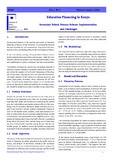| dc.contributor.author | Njeru, Enos H N | |
| dc.contributor.author | Orodho, John | |
| dc.date.accessioned | 2013-02-27T11:52:51Z | |
| dc.date.available | 2013-02-27T11:52:51Z | |
| dc.date.issued | 2003 | |
| dc.identifier.citation | IPAR Policy Brief Volume 9, Issue 3, 2003 | en |
| dc.identifier.uri | http://www.thutong.doe.gov.za/resourcedownload.aspx?id=7370 | |
| dc.identifier.uri | http://hdl.handle.net/11295/12060 | |
| dc.description | Education Financing in Kenya | en |
| dc.description.abstract | An historical analysis of the patterns and trends of education financing in Kenya reveals existence of a partnership between the state, households, and communities, long before the introduction of the cost-sharing policy by the Government of Kenya.
In the cost-sharing strategy, the government finances educational administration and professional services, while the communities, parents and sponsors, provide physical facilities, books and supplementary readers, stationery and other consumables.
The Ministry of Education, Science and Technology (MoES&T) operates a bursary scheme at secondary school level as part of, and within the auspices of the Social Dimensions of Development Programme, targeting the poor and vulnerable households. The major objective of the scheme is to enhance access to, and ensure high quality secondary school education for all Kenyans.
The philosophy behind the scheme was to translate into reality the idea that no child who qualifies for secondary education should be denied access due to inability to pay school fees | en |
| dc.language.iso | en | en |
| dc.publisher | IPAR | en |
| dc.subject | Education Financing | en |
| dc.subject | Bursary Scheme Implementation | en |
| dc.subject | Challenges | en |
| dc.subject | Kenya | en |
| dc.title | Education Financing in Kenya | en |
| dc.title.alternative | Secondary School Bursary Scheme Implementation and Challenges | en |
| dc.type | Other | en |
| local.publisher | College of Humanities and Social Sciences (CHSS) | en |

